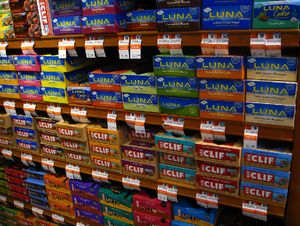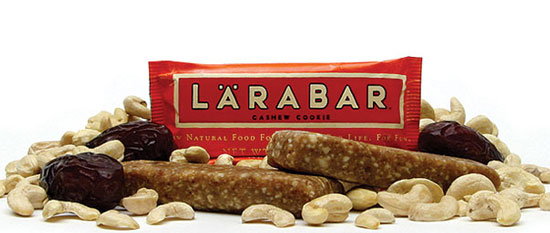Energy bars — YUCK, right? Well, we taste-tested 10 different energy bars to give you our take of the 10 best energy bars.
Great for quick bursts of energy while biking, hiking, skiing or any other outdoor activity, energy bars are hugely popular among adventure sport enthusiasts, and for good reason. They’re certainly not the only way to re-up your energy while out on a trail, but they’re tasty, extremely portable and reasonably cost effective.
But how do they stack up against each other? And even more importantly, how do they stack up against GORP?
Of course, taste is notoriously subjective. Not only that, but sometimes the things that taste good are terrible for us. A great piece of nutritional propaganda goes something like this: Snickers bars are a quick, surefire way to load up on energy. Riiight… if you don’t mind a mouthful of partially hydrogenated oils and tons of refined sugars!
But I digress.
We’re going to assume you’re leaving the bulky bag of sprouted almonds, dehydrated apples and GORP (good old raisins and peanuts) behind and want to tote along something a bit more manageable in terms of size.
Energy bars are great sources of fiber, vitamins, minerals, carbs, dietary fat and protein. They can be delicious and chewy or dry and grainy, so they’re not created equal. Some use a combination of organic and non-organic ingredients. Others use all raw, organic ingredients. Some, like a Snickers bar, say it’s energizing when it’s just a sugar high.
After our taste tests, we’ve compiled a list of ten of our favorite energy bars based on taste and nutritional value. Taste is obvious—we want it to be good. Nutritional value is vital for reenergizing ourselves on a long hike, bike ride or ski trip. At the end, we’ll tell you how the winner stacked up against GORP…
Basic Criteria of The 10 Best Energy Bars
Before we get to the list, we’ll mention the things you should look out for when buying an energy bar.
Carbs, protein content, caloric intake, dietary fiber, saturated fat and sugar (amount and source) should all be considered. Stay away from bars with more than 15-18 grams of sugar. It should have, at minimum, 3 grams of fiber and no more than 3-4 grams of saturated fat. We’re talking trans-fats—partially hydrogenated oils, palm kernel oil, etc.
Top 10 Energy Bars

10. Make your own! Who says you can’t mix up a bunch of your favorite vittles and make your own energy bar. Nuts, dried fruits, chocolate chips, oats, agave syrup, other ingredients—if others do it, so can you. You’ll save money in the long run and just might stumble onto the next big energy bar idea.
9. A 420-calorie beast, the Pemmican Fruit and Nut bar contains soy protein, corn and barley, with grape juice and honey sweeteners, for a moist, cakey taste treat delight. It provides nearly 60 grams of carbs and 16 grams of energy-rich protein. Basically, it passes a full meal.
8. ProBar jams 350 calories into one small treat. Nuts and fruit abound, with chocolate chips for sweetness. 15 natural ingredients with a carb-protein-fat ratio of 60-15-25 make it a super-healthy choice.
7. The Mojo Bar packs 200 calories into a tasty, crunchy package. Almonds, peanuts and crispy rice flavored with honey and oat syrup give it great flavor, and it’s healthy enough to do your body right.
6. Kashi TLC Chewy Granola Bar packs 5 grams of protein and 4 grams of fiber into a tasty bar that uses 7 whole grains. Dotted with dried cherries and dark chocolate, they’re flavorful, and with 24 carbs and 120 calories, they’ll give you a nice boost.
5. The Luna Bar, a Clif Bar product, is marketed to women, but all kinds of folks, young and old, like them. In the 180-calorie range, they offer 8-9 grams of protein and use roughly 70% organic ingredients. A great-tasting option while on the go. Even though it’s marketed to women, us dudes can devour them, too.
4. Wings of Nature energy bars are gluten and trans-fat free with no refined sugars. They use agave and brown rice syrup for sweetness and pack about 150-200 calories per serving. Great for walking and hiking.
3. Raw Revolution Bars are, to some, food for the gods. We like other varieties, too, but there’s plenty to rave about here. Totally organic, vegan, raw, green—you name it. Raw Evolution energy bars are gluten, wheat, peanut, animal product and preservative free. It’s like scooping up a clod of yummy, nutrient-rich earth and chowing down. Not really. It tastes far better than that. They have about 150 calories per bar and come in delicious flavors like lemon dew, spirulina and cashew and tropical banana.
2. Clif Bars come in a wide variety of flavors. They use organic brown rice syrup for carbs and sweetness and mostly contain soy protein for metabolism. Clif Bars provide all recommended daily amounts of vitamins C and E and are loaded with other nutrients. Moreover, we generally love the way they taste, especially the plain chocolate and the white chocolate and macadamia nut bar. You can’t go wrong with one of these boys. The biggest drawback? They sometimes have too much protein.

1. Larabars are produced entirely from raw ingredients, meaning whole and unprocessed. The body expends less energy breaking down these ingredients, so the net gain is higher. They include no more than 2-6 ingredients, digest easily and taste great. Larabars load you up with roughly 200 calories per snack and are gluten, soy, dairy and corn free. In our taste tests, Larabars came in a resounding first place! The only drawback: Almost all of them have coconut flakes and Allyson hates coconut!
Larabars VS GORP
In the end, the match-up between energy bars and GORP was a draw. Larabar definitely takes the cake for all energy bars, but it’s a tough match against GORP.
What’s YOUR Favorite Energy Bar?
We’ve given our taste test of our favorite energy bars. Now, how about you? What’s your favorite bar?











Speak Your Mind